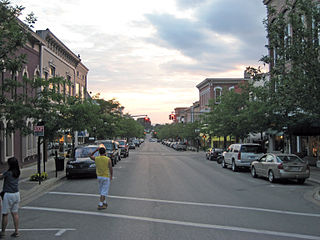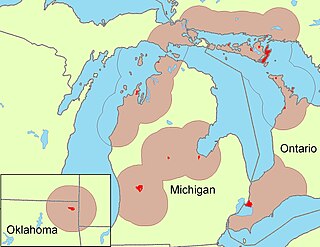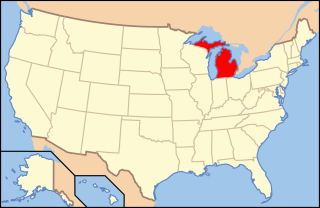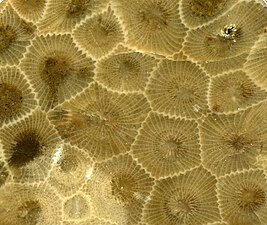
Lake Michigan is one of the five Great Lakes of North America. It is the second-largest of the Great Lakes by volume and depth after Lake Superior and the third-largest by surface area, after Lake Superior and Lake Huron. To the east, its basin is conjoined with that of Lake Huron through the wide and deep Straits of Mackinac, giving it the same surface elevation as its easterly counterpart; hydrologically, the two bodies are a single lake that is, by area, the largest freshwater lake in the world.

Emmet County is a county located in the U.S. state of Michigan. As of the 2020 census, the population was 34,112, making it the second-most populous county in Northern Michigan. The county seat is Petoskey, which is also the county's largest city.

Harbor Springs is a city and resort community in Emmet County, Michigan, United States. The population was 1,274 in the 2020 census.

Petoskey is the largest city and the county seat of Emmet County, Michigan, and is the largest settlement within the county. Petoskey has a population of 5,877 at the 2020 census, up from 5,670 at the 2010 census.

Ada Township is a civil township of Kent County in the U.S. state of Michigan. The population was 14,388 at the 2020 census.

St. Ignace is a city in the U.S. state of Michigan and the county seat of Mackinac County. The city had a population of 2,306 at the 2020 census. St. Ignace Township is located just to the north of the city; the two are administered separately.
Petoskey may refer to a number of articles relating to the U.S. state of Michigan:

The Odawa are an Indigenous North American people who primarily inhabit land in the Eastern Woodlands region, now in jurisdictions of the northeastern United States and southeastern Canada. Their territory long preceded the creation of the current border between the two countries in the 18th and 19th centuries.

Northern Michigan is a region of the U.S. state of Michigan. The region, which is distinct from the more northerly Upper Peninsula and Isle Royale, which are also located in the north of the state, is bounded to the west by Lake Michigan, and to the east by Lake Huron. The Upper Peninsula is accessible from the region via the Mackinac Bridge. While the region's southern boundary is not precisely defined, most definitions include the northernmost 21 counties of the Lower Peninsula, which had a population of 506,658 people at the 2020 census. Its largest cities are Traverse City, Cadillac, Alpena, Ludington, Manistee, and Petoskey.

The Little Traverse Bay Bands of Odawa Indians is a federally recognized Native American tribe of Odawa. A large percentage of the more than 4,000 tribal members continue to reside within the tribe's traditional homelands on the northwestern shores of the state of Michigan's Lower Peninsula. The historically delineated reservation area, located at 45°21′12″N84°58′41″W, encompasses approximately 336 square miles (870 km2) of land in Charlevoix and Emmet counties. The largest communities within the reservation boundaries are Harbor Springs, where the tribal offices are located; Petoskey, where the Tribe operates the Odawa Casino Resort; and Charlevoix.
Petosegay or Biidassige was a 19th-century Odawa merchant and fur trader. Both present-day Petoskey, Michigan, Petoskey State Park, and nearby Emmet County park Camp Petosega are named in his honor. A particular variety of stone was found in abundance on his former lands and named after him, and the Petoskey stone was designated as the official state stone. His granddaughter, Ella Jane Petoskey, was asked by Michigan Governor George W. Romney to be an honored signatory on the bill assigning the Petoskey Stone as the state stone.
Antoine Carré was a French explorer and fur trader. After marrying the daughter of an Ottawa chieftain, he became founder and leader of the Bear River Ottawa during the mid-18th century, when he was known in Odawa as Neaatooshing.

Hexagonaria is a genus of colonial rugose coral. Fossils are found in rock formations dating to the Devonian period, about 350 million years ago. Specimens of Hexagonaria can be found in most of the rock formations of the Traverse Group in Michigan. Fossils of this genus form Petoskey stones, the state stone of Michigan. They can be seen and found in most Midwestern U.S. states.

Paleontology in Michigan refers to paleontological research occurring within or conducted by people from the U.S. state of Michigan. During the Precambrian, the Upper Peninsula was home to filamentous algae. The remains it left behind are among the oldest known fossils in the world. During the early part of the Paleozoic Michigan was covered by a shallow tropical sea which was home to a rich invertebrate fauna including brachiopods, corals, crinoids, and trilobites. Primitive armored fishes and sharks were also present. Swamps covered the state during the Carboniferous. There are little to no sedimentary deposits in the state for an interval spanning from the Permian to the end of the Neogene. Deposition resumed as glaciers transformed the state's landscape during the Pleistocene. Michigan was home to large mammals like mammoths and mastodons at that time. The Holocene American mastodon, Mammut americanum, is the Michigan state fossil. The Petoskey stone, which is made of fossil coral, is the state stone of Michigan.
The Traverse Group is a geologic group in Michigan, Indiana and Ohio comprising middle Devonian limestones with calcareous shale components. Its marine fossils notably include Michigan's state stone, the Petoskey stone, among other corals and records of ancient marine life. A range of trilobites has also been found in the Traverse Group.
Thunder Bay Limestone is a geologic formation in Michigan that preserves fossils dating back to the Middle Devonian and is the uppermost formation of the Traverse Group.

The recorded history of Grand Rapids in the U.S. state of Michigan, began with settlers in 1806.
Events from the year 1885 in Michigan.















